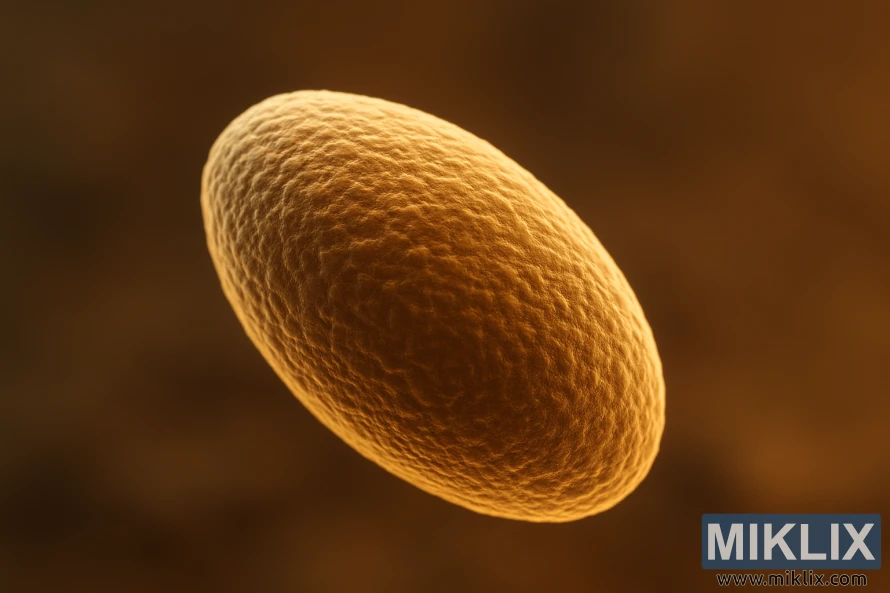Image: Microscopic View of a German Lager Yeast Cell
Published: October 29, 2025 at 10:07:27 PM UTC
High-magnification image of a German lager yeast cell, illuminated with warm lighting to reveal its elliptical shape and detailed cellular texture.
The image presents a striking and scientifically evocative close-up of a German lager yeast cell, captured under high magnification to reveal the intricate details of its structure. The side profile view emphasizes the cell’s characteristic elliptical shape, with gently tapering ends that distinguish it from other microorganisms. Its surface texture, illuminated by soft, warm lighting, appears almost tactile—covered in subtle ridges, undulations, and dimples that suggest both the complexity of the yeast’s cellular wall and the biological processes taking place within. The lighting design is particularly effective, bathing the cell in a golden glow that highlights every contour while creating a natural sense of depth. Shadows play softly across the textured surface, enhancing the three-dimensional impression of the microscopic subject.
The background is deliberately blurred, with a gradient of warm amber and brown tones that recalls the color palette of lager beer itself. This subtle association ties the scientific precision of the image back to its cultural and culinary importance. By eliminating distractions, the blurred backdrop allows the eye to remain focused solely on the yeast cell, emphasizing its role as the central subject and its importance in fermentation. The depth of field ensures that the viewer’s attention is drawn immediately to the sharp details of the cell’s surface, which resembles a micro-landscape of hills and valleys—an organic architecture designed by nature to support one of humanity’s oldest and most beloved fermentation processes.
From a scientific perspective, the image conveys both technical accuracy and aesthetic appreciation. Yeast cells such as this are the driving force behind the production of lager beers, a cornerstone of German brewing tradition. They convert sugars into alcohol and carbon dioxide, shaping not only the flavor and texture of the beer but also its storied history. The elliptical form and the thickness of the cell wall are distinctive markers of lager yeast strains, such as Saccharomyces pastorianus, which thrive at cooler fermentation temperatures and are responsible for producing the clean, crisp qualities that define this style of beer. This image, though magnified beyond ordinary perception, encapsulates that role visually, elevating the yeast cell to an object of fascination and respect.
The composition reflects a perfect balance between scientific rigor and artistic expression. The golden hue evokes warmth and tradition, linking the microbiological subject with the cultural context of brewing. The blurred, softly glowing background lends an almost atmospheric quality, as though the yeast cell is suspended in a liquid environment, quietly carrying out its essential role. Together, these visual elements highlight not just the physical form of the yeast, but its symbolic role as the unseen yet indispensable engine of fermentation. The result is an image that embodies both precision and poetry: a single yeast cell rendered monumental, suspended in time and space, representing the bridge between microscopic life and human craft.
The image is related to: Fermenting Beer with Bulldog B34 German Lager Yeast

